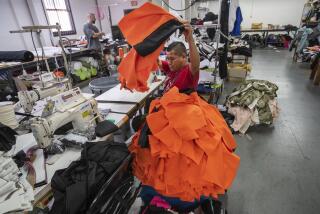August Factory Orders Drop as Construction Outlays Leap
- Share via
WASHINGTON — Orders to U.S. factories fell 1.7% in August as a big drop in demand for aircraft and weaker military orders contributed to the first setback in manufacturing since January, the government said Thursday.
The Commerce Department said orders for both durable and non-durable goods declined to $202.5 billion in August, following a small 0.3% gain in July.
Some analysts said the weakness in August was merely a temporary setback after a string of healthy gains, but other economists said the downturn may be more ominous, especially given the fact that inventories have been rising as well.
In a second report, the Commerce Department said construction spending shot up 1.6% in August to an annual rate of $399.6 billion, the biggest increase in four months.
Analysts dismissed the gain as a temporary upturn which did not change their view that construction will be a drag on economic growth this year because of widespread overbuilding in offices and apartments, and the adverse impact of the new tax law.
The report on factory orders showed weakness in both military and civilian orders in August. Demand for military equipment fell 3.8% to $9.6 billion.
Orders in the key category of non-defense capital goods, a good indication of business investment plans, plunged a sharp 8.1%.
Some economists viewed the setback in capital equipment orders as a reflection that higher interest rates were forcing businesses to scale back their equipment purchases.
But Michael Penzer, an economist at Bank of America in San Francisco, said the setback in capital equipment followed strong gains during the early part of the year. He said that for the first seven months of the year, capital equipment orders had been rising by an average of 1.5% a month.
He also dismissed the overall drop in orders for August, contending that gains in overseas sales by American businesses had already translated into higher factory production and would continue to do so.
“To have a one month decline is nothing to get worried about. The trend is very positive, reflecting increasing exports of U.S. manufactured goods,” he said.
The 1.7% drop in August orders was the first decline since a record 5.3% fall last January, a decrease that had been blamed on initial turmoil caused by the new tax law.
Michael Evans, head of a Washington forecasting firm, took a more pessimistic view of the August figures, noting that inventories of manufactured goods rose 0.6% in August.
“We have the wrong combination. We have orders going way down and inventories going way up,” he said.
Evans said he believed that the growth in unsold inventories and weak demand for new orders would hold back overall economic activity in coming months. He predicted that the economy, as measured by the gross national product, will expand at a sluggish 2% rate in the second half of the year.
This is more pessimistic than most economists, who are calling for growth of about 3% in the second half of the year, down only slightly from the 3.4% growth in the first six months of the year.
In August, new orders for durable goods, items expected to last three or more years, fell 2.7%. This was a slight revision from an advance report last week that put the decline at 3.1%.
Orders for non-durable goods fell 0.6% in August, reversing a 0.6% increase in July. Some of the largest declines were in textiles and paper products.
The decline in military orders was the second in a row, following an even larger 6.2% drop in July. Without the weakness in military equipment, factory orders would have still fallen by 1.6%, the first decline in the civilian category since January.
By industry, the biggest decline was in the transportation sector, where orders fell 3.9% to $26.9 billion, with a decrease in demand for aircraft more than offsetting an increase in orders for motor vehicles.
More to Read
Inside the business of entertainment
The Wide Shot brings you news, analysis and insights on everything from streaming wars to production — and what it all means for the future.
You may occasionally receive promotional content from the Los Angeles Times.









